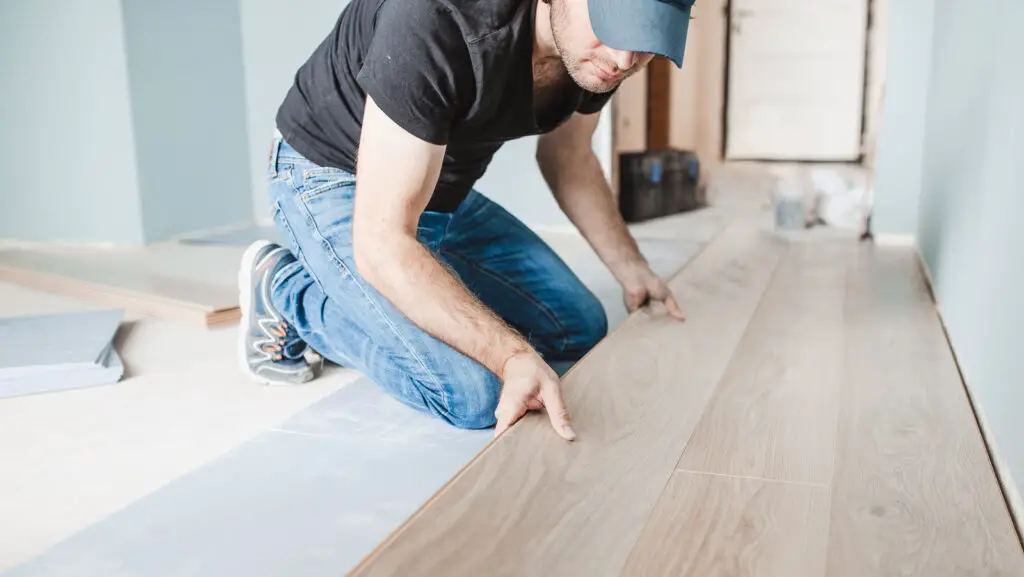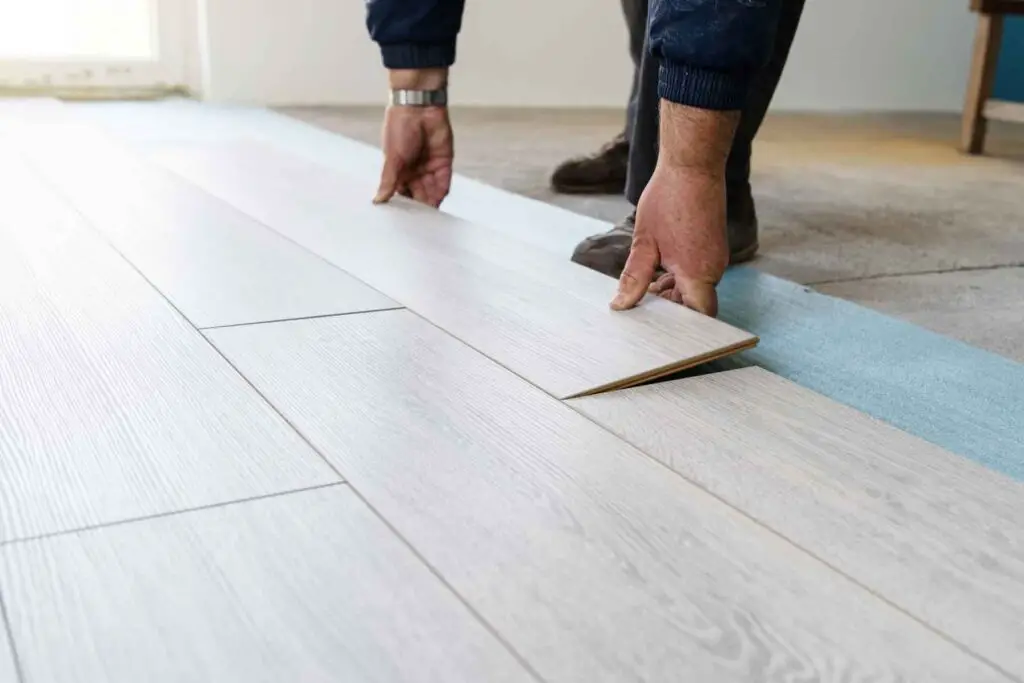If you’ve noticed that your laminate flooring feels squishy as you walk on it, you’re probably wondering why this is happening and how you can fix it. A squishy or spongy sensation in laminate flooring can be disconcerting and may indicate underlying issues that need to be addressed.
This article will delve into the various reasons why your laminate flooring feels squishy and provide practical solutions to this common problem. Let’s demystify this squishy phenomenon and restore your floor to its rightful firmness.
Understanding Why Laminate Flooring Feels Squishy
“Squishy” laminate flooring is characterized by an unusually soft and pliable sensation underfoot, similar to walking on a sponge or a water-filled mattress. When pressure is applied, such as when stepping on the floor, it sinks or depresses slightly, and might even produce a subtle, disconcerting sound.
This sensation is unlike the typical hard, solid feel of well-installed laminate flooring which is normally resilient and stable.
The squishiness can be localized to certain areas of the floor or may be widespread, impacting the overall comfort and safety of your home.
Root Causes of Squishy Laminate Flooring

There are several potential root causes for squishy laminate flooring, which could be due to improper installation or environmental factors.
Improper Installation:
Laminate floors should be installed on a completely flat, level surface. If the subfloor is uneven or has high and low spots, it can cause the laminate to flex and give a squishy feel as you walk on it. Similarly, if the laminate was installed without a proper underlayment, this can also lead to a squishy feel.
Moisture Issues:
Laminate flooring is highly susceptible to damage from moisture and humidity. If there are undetected leaks from pipes or appliances, or if the floor is in a high-humidity area like a bathroom or kitchen without proper moisture barriers, water can seep into the layers of the laminate, causing it to swell and feel squishy underfoot.
Poor Quality Material:
Not all laminate flooring is created equal. Lower-quality laminate may not be as stable or resilient as higher-quality options, leading it to be more susceptible to wear and tear and thus becoming squishy over time.
Wear and Tear:
Over time, regular wear and tear from foot traffic, moving furniture, or heavy appliances can cause the laminate to compress and squish. This is more common in high-traffic areas or where heavy furniture is frequently moved.
The Impact of Squishy Laminate Flooring
Squishy laminate flooring, while perhaps appearing to be a minor inconvenience, can present serious damages and risks if left unaddressed.
Structural Damage:
The squishiness can signify underlying water damage or uneven subfloors, which may compromise the structural integrity of the flooring. Over time, the floors may warp or buckle, requiring costly repairs or replacement.
Mold and Mildew:
If the squishy feeling is due to moisture, it can foster the growth of mold and mildew. These fungi can harm indoor air quality, potentially causing allergic reactions or respiratory issues.
Slip and Fall Hazards:
A squishy or uneven floor can increase the risk of slips, trips, and falls, leading to potential injuries.
Aesthetic Concerns:
Squishy laminate floors are often visually unappealing, with visible signs of damage like swelling or warping. This can detract from your home’s overall aesthetics, impacting its value.
Effects on the Flooring’s Lifespan and Aesthetics
The lifespan and aesthetics of your laminate flooring can be drastically impacted by squishiness.
Lifespan:
Laminate floors are expected to last between 15 and 25 years under normal conditions. However, squishy flooring often signifies underlying issues like water damage or subfloor unevenness, which can significantly shorten this lifespan.
The continual strain from foot traffic or heavy furniture on the squishy area could accelerate the deterioration, leading to premature wear and tear. This could necessitate premature replacement of the flooring, resulting in additional costs.
Aesthetics:
Besides its impact on structural integrity, squishiness also affects the visual appeal of your laminate flooring. Ideally, laminate floors should offer a sleek, clean look, enhancing your home’s decor.
However, squishy laminate flooring often exhibits visible signs of damage, such as swelling, warping, or discoloration. These signs of distress can detract from the overall aesthetic appeal of your space.
In extreme cases, the laminate could peel or crack, revealing the underlayment or subfloor, which is a clear aesthetic downgrade.
How to Fix Squishy Laminate Flooring

Step 1: Initial Observation
The first step when your laminate flooring feels squishy is to observe the affected area closely. Look for visible signs of damage such as swelling, warping, or discoloration. These could indicate water damage or other issues that are causing the squishiness.
Step 2: Testing the Squishy Area
After observing, test the squishy area by walking over it and feeling the extent of its sponginess. This step gives you a better understanding of the severity of the problem. If the laminate flooring feels excessively squishy or unstable, it is more likely that there is a more significant underlying issue.
Step 3: Checking for Water Damage
Water damage is often the primary culprit when laminate flooring feels squishy. Check for any water sources such as leaks from a refrigerator, sink, or other appliances that may be contributing to the problem. Also, inspect the ceiling and walls for any signs of water leakage.
Step 4: Inspecting the Subfloor
If there’s no water damage present, the problem might be with the subfloor. A subfloor that’s uneven or not properly prepared can cause laminate flooring to feel squishy.
To inspect the subfloor, you’ll need to lift a section of the laminate flooring. Look for any irregularities, unevenness, or signs of damage on the subfloor.
Step 5: Consulting a Professional
If the cause of the squishiness is still unclear after the above steps, it’s time to consult a professional. They will have the expertise and equipment to properly diagnose and fix the problem.
Remember, it’s always better to address the issue promptly rather than letting your laminate flooring feels squishy, causing potential long-term damage.
Exploration of Various Solutions Based on the Root Cause
Determining the appropriate solution for squishy laminate flooring heavily depends on the identified root cause.
Solution for Water Damage:
If you’ve found water damage to be the cause, it’s crucial to first stop the source of the water. This could involve fixing a leaking appliance or sealing gaps where water can seep in. Once the source is eliminated, you might need to replace the water-damaged sections of your laminate flooring and possibly the subfloor.
Solution for Subfloor Irregularities:
If the subfloor is found to be uneven or improperly prepared, you may need to correct this before reinstalling your laminate flooring. You can use a self-leveling compound to even out minor irregularities. For significant issues, consider hiring a professional to ensure the subfloor is adequately prepared.
Solution for Unknown Cause:
If the specific cause isn’t clear even after inspection, a flooring professional can help. They might suggest options such as reinstallation of the laminate flooring using a different underlayment or a complete replacement of the flooring depending on the severity of the issue.
Related Topics:
Preventive Measures
Proper Installation: Ensure your laminate flooring is correctly installed to begin with. This includes preparing an even subfloor and using the appropriate underlayment to provide a solid foundation for the laminate flooring.
Mitigate Water Exposure: Do not allow water to sit on the surface of your laminate flooring. Wipe up any spills immediately. In areas prone to water exposure, such as bathrooms or kitchens, consider using water-resistant laminate flooring.
Regular Cleaning: Regularly clean your laminate flooring with a slightly damp mop, avoiding the use of excess water. Do not use steam cleaners or wet mops, which may cause water to seep into the gaps and cause damage.
Humidity Control: Since humidity can cause the laminate to expand and contract, try to maintain a consistent indoor climate. Utilize dehumidifiers during damp, and humid months and humidifiers during dry seasons.
Avoid Heavy Loads: Avoid placing excessively heavy furniture or appliances on your laminate flooring which can cause undue stress or deformation.
Routine Inspections: Regularly inspect your laminate flooring for signs of damage or wear. Address minor issues promptly before they escalate and cause more significant problems.
Conclusion
In conclusion, squishy laminate flooring is more than just an inconvenience; it’s a clear indication of underlying issues that can affect the integrity, aesthetics, and safety of your home.
Whether the squishiness is due to improper installation, water damage, poor-quality materials, or natural wear and tear, it’s crucial to diagnose and address the root cause promptly.
Regular maintenance, including proper cleaning, humidity control, and routine inspections, can help to prevent such issues from arising. By understanding and implementing these strategies, you can ensure the longevity of your laminate flooring and continue to enjoy its beauty and durability for years to come.
FAQs
Can I use a vacuum cleaner for laminate flooring?
Yes, you can use a vacuum cleaner for laminate flooring. However, it’s advisable to use a vacuum without a beater bar or one where you can turn the beater bar off to avoid scratching the surface.
Is it safe to use vinegar or other household cleaners on my laminate floor?
While vinegar is commonly used for cleaning purposes, it’s not recommended for laminate floors as it can dull the finish over time. Instead, use cleaning products specifically designed for laminate flooring. Always avoid the use of abrasive cleaners that can scratch or damage your floors.

2 thoughts on “Why Your Laminate Flooring Feels Squishy and What to Do About It”